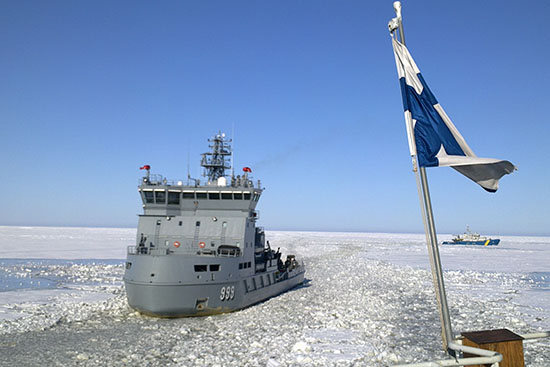A tanker has run aground off the Oulu coast, and heavy fuel oil has spilled at sea. This frightening scenario is the starting point for an international Arctic oil recovery exercise at the Bay of Bothnia.
The purpose of the exercise is to test Arctic oil spill prevention and rescue procedures in real-life circumstances, when the sea is covered with ice. The exercise takes place on Wednesday 7 March
“The environmental risks in the Arctic region have increased during the past decades. International cooperation will help create the conditions necessary for protecting the sea environment from oil spills”, says unit director Jorma Rytkönen of the Finnish Environment Institute SYKE.
SYKE is organizing the exercise in close co-operation with the Swedish Coast Guard. The exercise gets support from the Finnish Ministry for Foreign Affairs, Finnish Ministry of the Environment and the Emergency Prevention, Preparedness and Response (EPPR) working group of the Arctic Council.
The event runs under the Agreement on Cooperation on Marine Oil Pollution Preparedness and Response in the Arctic (MOSPA) and the Copenhagen agreement. In 2013, the eight Arctic States signed the “Agreement on Cooperation on Marine Oil Pollution Preparedness and Response in the Arctic”. Since the signing of the agreement, the Arctic States have conducted MOSPA exercises.
In the oil spill response scenario simulated in the Oulu exercise, a tanker called Finter has run aground off the Oulu coast. The vessel has been towed to the Oulu port, but 2000 -3000 tons of heavy fuel oil have already spilled at sea. The emergency duty officer of the Finnish Environment Institute has sent (test) alarms to the Arctic Council member countries. SYKE has also called in several oil spill prevention vessels from Finland and asked for help from Sweden.
The exercise involves a plane of the Finnish Border Guard, as well as several vessels equipped with mechanical brush skimmers that are suited for oil spill response in ice conditions. No real oil is used during the event.
“The meteorological conditions can change our exercise plans for the exercise, for example if the ice conditions are such that the ships cannot come near the simulated oil spill area”, Jorma Rytkönen notes.
One of the vessels participating in the exercise is multipurpose vessel Louhi that is taking a group of officials and media representatives onboard to observe the exercise.
The public is welcome to follow the exercise in real time. The live broadcast begins at 9:00 Finnish time and will continue until the end of the exercise with interviews of the responsible officials and updates from situation awareness system BORIS as well as aerial pictures.

While the oil spill rescue personnel is working hard at sea, some 200 international experts are taking part in a conference focusing on pollution response aspects in the Arctic. The themes of the conference include the Arctic environment, mechanical oil recovery in ice conditions, ice and weather services in the Arctic region, properties of vessels in ice conditions, and environmental monitoring.
One conference participant is Niko Hänninen, project manager of Arctic Preparedness Platform for Oil Spill and other Environmental Accidents (APP4SEA).
“In our project we have several building blocks that together will improve oil spill preparedness in the Arctic areas. We want to contribute to increasing awareness on the state of our oil spill response in general, and learn from the best practices of others."
APP4SEA is currently collecting information on the infrastructures in the Arctic region, on the fauna, and on the areas that are especially vulnerable to oil spills. One aim of the project is to develop an application that will include meteorological conditions and flow scenarios.
“Many countries already use similar software, but they only serve in the national framework. We are developing a tool that would cover the Arctic sea regions to help the authorities if there is an accident and oil spill threatens in areas where the national tools will not work”, Niko Hänninen explains.
“I am looking forward to the Oulu conference. Our Norwegian partner will talk about models for oil flow and our Scottish partner has a presentation on the oil vulnerability index of birds. The conference will give valuable information on the threats to the Arctic environment, and on how we can prepare for them.”
Photos © Jouko Pirttijärvi, SYKE